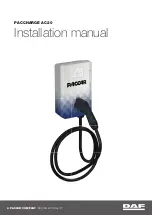
To avoid hazardous situations:
R
never install snow chains to the front
wheels
R
always install snow chains in pairs to the
rear wheels.
For safety reasons, Mercedes-Benz recom-
mends that you only use snow chains that
have been specially approved for your vehicle
by Mercedes-Benz, or are of a corresponding
standard of quality. For more information,
please contact a qualified specialist workshop.
If you intend to mount snow chains, please
bear the following points in mind:
R
Snow chains may not be mounted on all
wheel/tire combinations. Permissible
wheel-tire combinations (
Y
page 318).
R
Only use snow chains when driving on roads
completely covered by snow. Remove the
snow chains as soon as possible when you
come to a road that is not snow-covered.
R
Local regulations may restrict the use of
snow chains. Observe the appropriate regu-
lations if you wish to mount snow chains.
R
Do not exceed the maximum permissible
speed of 30 mph (50 km/h).
R
On vehicles with Active Body Control (ABC),
if snow chains have been installed, you must
drive at a raised vehicle level (
Y
page 168).
You may wish to deactivate ESP
®
when pulling
away with snow chains installed (
Y
page 66).
You can thereby allow the wheels to spin in a
controlled manner, achieving an increased
driving force (cutting action).
Tire pressure
Tire pressure specifications
Important safety notes
G
WARNING
Underinflated or overinflated tires pose the
following risks:
R
the tires may burst, especially as the load
and vehicle speed increase.
R
the tires may wear excessively and/or
unevenly, which may greatly impair tire
traction.
R
the driving characteristics, as well as
steering and braking, may be greatly
impaired.
There is a risk of an accident.
Follow recommended tire inflation pressures
and check the pressure of all the tires
including the spare wheel:
R
monthly, at least
R
if the load changes
R
before beginning a long journey
R
under different operating conditions, e.g.
off-road driving
If necessary, correct the tire pressure.
The data on the Tire and Loading Information
placard and tire pressure table shown here are
examples. Tire pressure specifications are
vehicle-specific and may deviate from the data
shown here. The tire pressure specifications
that are valid for your vehicle can be found on
the Tire and Loading Information placard and
tire pressure table on the vehicle.
General notes
The recommended tire pressures for the tires
mounted at the factory can be found on the
labels described here.
Further information on tire pressures can be
obtained at a qualified specialist workshop.
296
Tire pressure
Wheels
and
tir
es
Summary of Contents for SL 450 2019
Page 330: ...328...
















































